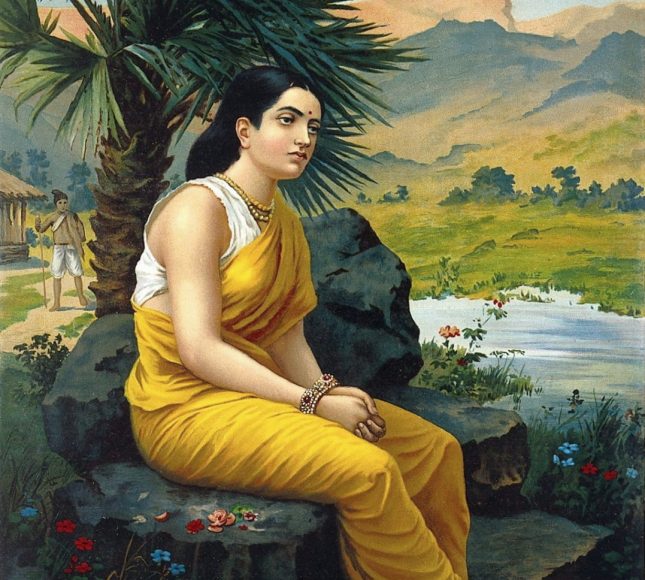SITA The ten-headed Ravana has taken away Sita, therefore Rama grieves….. (Shalok Varan te Vadhik, M. l, p. 1412) The false Gurus sing about the episode of Rama and Sita. (Var Asa M. l, p. 465) Rama had lost his wife and had to wage a war with Ravana. (Gond Namdev, p. 875) Sita was the daughter of Janaka Videhi, the king of Mithila. For her marriage, a Swayyamavara was arranged. It was proclaimed that whosoever would bend the bow of Shiva, would be married with the princess.
Several princes tried, but it was only Rama who was successful in this brave act. After her marriage she went to Ayodhya with her husband. Rama was the crown prince, but before the coronation, his step-mother Kaikeyi prevailed upon the king to banish him from the kingdom for fourteen years and instead install her son Bharata in his place. Sita accompanied Rama in his exile, but was carried away by Ravana, the king of Lanka.
The tyrant king made every effort to win her to his will, but could not do so. A great war ensued between Rama and his allies on one side and the armies of Ravana on the other. Ultimately, the demon king was killed, but this pious and chaste great lady had to pass through a fire-ordeal as a proof of her innocence for the world. After that she returned with her husband to Ayodhya. But before she gave birth to her twins Lava and Kusha, she was sent to the hermitage of Valmiki because of a slanderous utterance of a washerman.
There she lived till her sons mastered all the arts of war and intercepted the Ashvamedha Yajna (horse-sacrifice) of their father. When Rama came to know to their identity, he called back Sita. But her heart was very heavy because of the treatment meted out by her. She wanted to go back to the mother-earth from which she is said to have sprung up. Because of her wish, the ground opened and she was tåken back into the source.
The word ‘Sita’ ordinarily means ‘a furrow’. In the Ramayana her father says that he found her while ploughing his field. For this reason, she is sometimes called Ayoni-ja (not born from the womb). Being the daughter of the king Janaka, she is also called Janaki. See : Rama Lakshmana and Janaka
References :
1. Kohli,Surindar Singh ed,Dictionary of Mythological References in Guru Granth Sahib 1993
Sita, also known as Janaki, Vaidehi, and Maithili, is one of the most revered figures in Hindu mythology. She is the central female character in the epic Ramayana and is regarded as an incarnation of Goddess Lakshmi, the consort of Lord Vishnu. Sita is celebrated for her virtues of devotion, purity, and resilience, embodying the ideal woman, wife, and daughter.
Key Aspects of Sita:
Birth and Origins:
- Sita is described as the daughter of Bhumi Devi (Mother Earth). According to legend, she was discovered by King Janaka of Mithila while plowing a field, leading to her name “Sita,” which means “furrow” in Sanskrit.
- She was raised as the princess of Mithila and is also known as Janaki (daughter of Janaka) and Maithili (princess of Mithila).
Marriage to Rama:
- Sita’s marriage to Lord Rama, the prince of Ayodhya and an avatar of Vishnu, was determined through a swayamvara. Rama won her hand by lifting and stringing the divine bow of Lord Shiva, a feat no other suitor could accomplish.
Exile and Abduction:
- Sita accompanied Rama during his 14-year exile, showcasing her unwavering devotion and commitment as a wife.
- During their stay in the Dandaka forest, Sita was abducted by Ravana, the demon king of Lanka, and held captive in the Ashoka Vatika. Despite Ravana’s attempts to win her over, Sita remained steadfast in her loyalty to Rama.
Rescue and Agni Pariksha:
- Sita was rescued by Rama with the help of Hanuman and the Vanara army after a fierce battle in Lanka.
- To prove her chastity and purity, Sita underwent the Agni Pariksha (trial by fire), emerging unscathed, symbolizing her virtue and strength.
Later Life:
- After returning to Ayodhya, Sita faced further trials when her chastity was questioned by society. She chose to leave the palace and sought refuge in the hermitage of Sage Valmiki, where she gave birth to her twin sons, Lava and Kusha.
- In the end, Sita returned to her mother, Bhumi Devi, who embraced her into the Earth, symbolizing her ultimate liberation and purity. Symbolism and Legacy:
- Sita represents dharma (righteousness), sacrifice, and devotion, serving as a role model for women and men alike.
- Her story highlights the virtues of resilience, faith, and adherence to moral principles, even in the face of immense challenges.
Sita’s life and character continue to inspire devotion and reverence, making her a timeless figure in Hindu mythology. You can explore more about her story here or here. Let me know if you’d like to delve deeper into specific episodes of her life or her spiritual significance!



